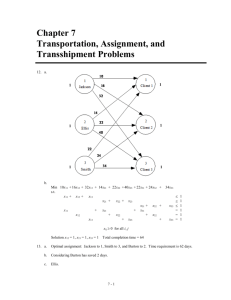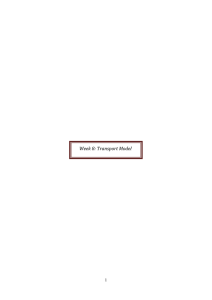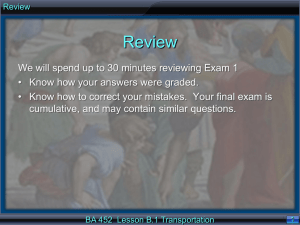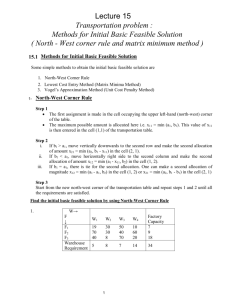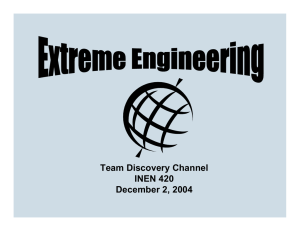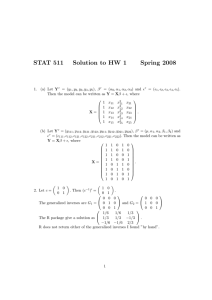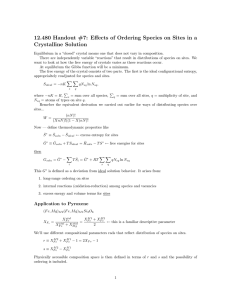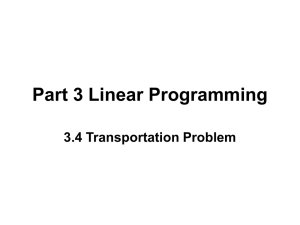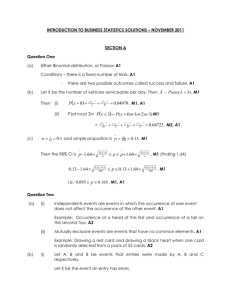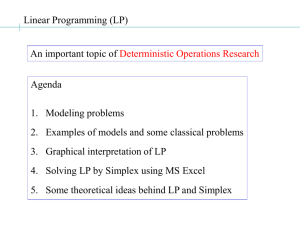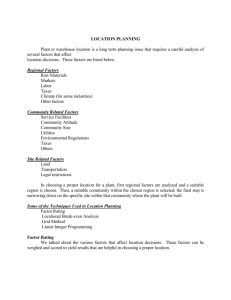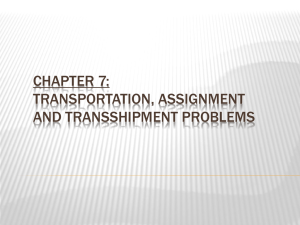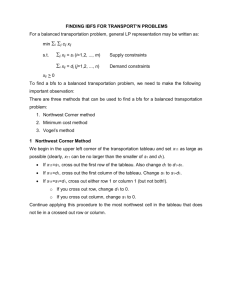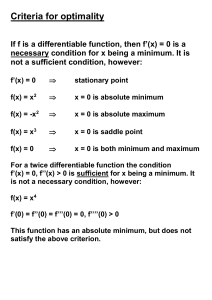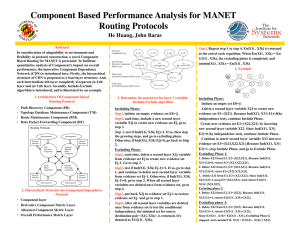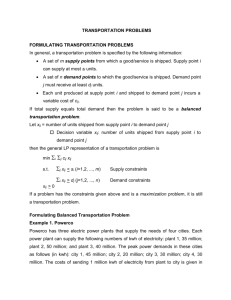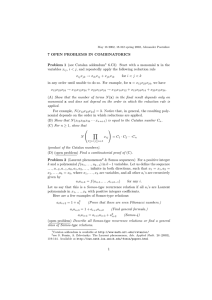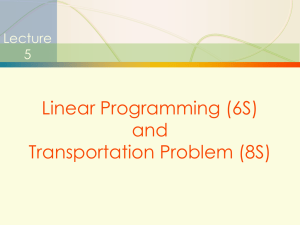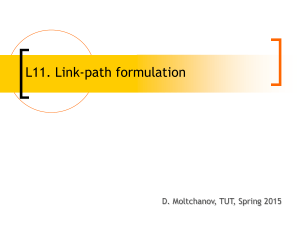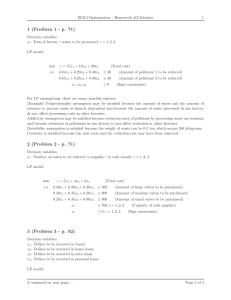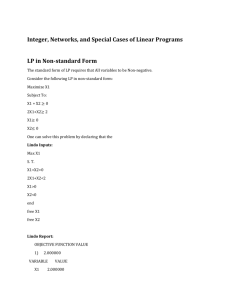Transportation Models - Business Management Courses
advertisement
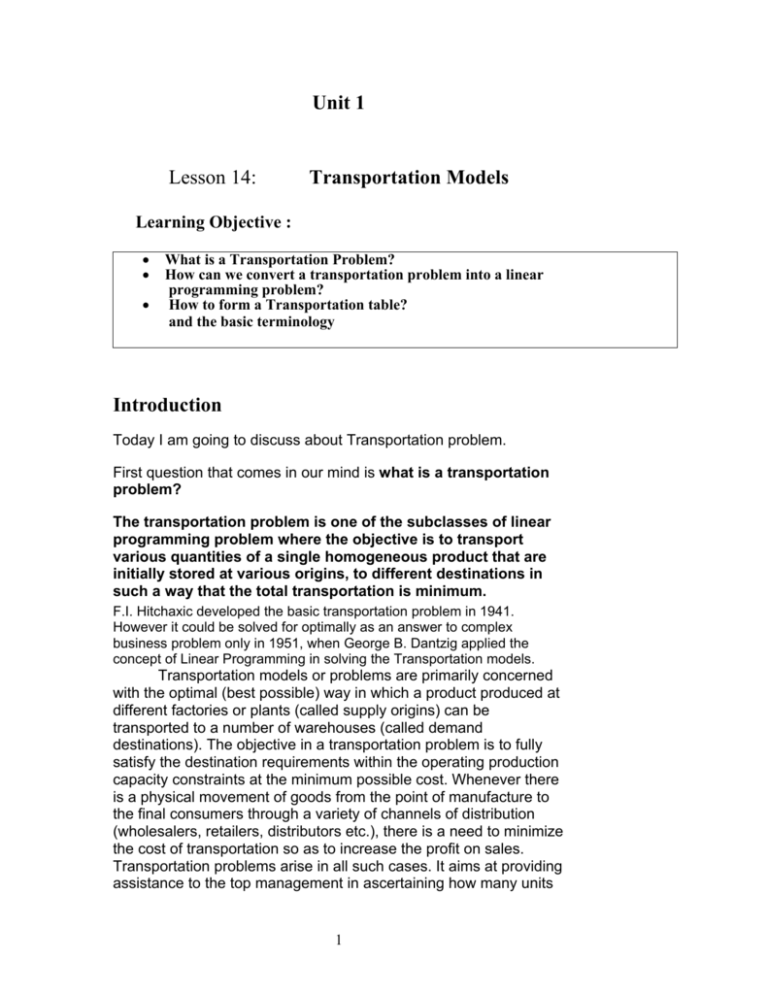
Unit 1 Lesson 14: Transportation Models Learning Objective : • • • What is a Transportation Problem? How can we convert a transportation problem into a linear programming problem? How to form a Transportation table? and the basic terminology Introduction Today I am going to discuss about Transportation problem. First question that comes in our mind is what is a transportation problem? The transportation problem is one of the subclasses of linear programming problem where the objective is to transport various quantities of a single homogeneous product that are initially stored at various origins, to different destinations in such a way that the total transportation is minimum. F.I. Hitchaxic developed the basic transportation problem in 1941. However it could be solved for optimally as an answer to complex business problem only in 1951, when George B. Dantzig applied the concept of Linear Programming in solving the Transportation models. Transportation models or problems are primarily concerned with the optimal (best possible) way in which a product produced at different factories or plants (called supply origins) can be transported to a number of warehouses (called demand destinations). The objective in a transportation problem is to fully satisfy the destination requirements within the operating production capacity constraints at the minimum possible cost. Whenever there is a physical movement of goods from the point of manufacture to the final consumers through a variety of channels of distribution (wholesalers, retailers, distributors etc.), there is a need to minimize the cost of transportation so as to increase the profit on sales. Transportation problems arise in all such cases. It aims at providing assistance to the top management in ascertaining how many units 1 of a particular product should be transported from each supply origin to each demand destinations to that the total prevailing demand for the company’s product is satisfied, while at the same time the total transportation costs are minimized. Mathematical Model of Transportation Problem Mathematically a transportation problem is nothing but a special linear programming problem in which the objective function is to minimize the cost of transportation subjected to the demand and supply constraints. Let ai = quantity of the commodity available at the origin i, bj = quantity of the commodity needed at destination j, cij = transportation cost of one unit of a commodity from origin I to destination j, and xij = quantity transported from origin I to the destination j. Mathematically, the problem is Minimize z = ∑∑ xij cij S.t. ∑xij = ai, i= 1,2,…..m ∑xij = bj, j= 1,2,…..,n and xij ≥ 0 for all i and j . Let us consider an example to understand the formulation of mathematical model of transportation problem of transporting single commodity from three sources of supply to four demand destinations. The sources of supply can be production facilities, warehouse or supply point, characterized by available capacity. The destination are consumption facilities, warehouse or demand point, characterized by required level of demand. FORMULATION OF TRANSPORATATION PROBLEM AS A LINEAR PROGRAMMING MODEL Let P denote the plant (factory) where the goods are being manufactured & W denote the warehouse (godown) where the 2 finished products are stored by the company before shipping to various destinations. Further let, xij = quantity (amount of goods) shipped from plant Pi to the warehouse Wj, and Cij = transportation cost per unit of shipping from plant Pi to the Warehouse Wj. Objective-function. The objection function can be represented as: Minimize cost of shipping from a plant ware house) Z = c11x11 + C12x12 + C13x13 (i.e. + c21x21 + c22x22 + c23x23 + c31x31 + c32x32 + c33x33 to the Supply constraints. x11 + x12 + x13 = S1 x21 + x22 + x23 = S2 x31 + x32 + x33 = S3 Demand constraints. x11 + x21 + x31 = D1 x21 + x22 + x23 = D2 x31 + x32 + x33 = D3 Either, xij ≥ for all values of I and j (ie; x11, x12, … all such values are ≥ 0) S1 + S2 + S3 = D1 + It is further assumed that: D2 + D3 i.e.; The total supply available at the plants exactly matches the total demand at the destinations. Hence, there is neither excess supply nor excess demand. Such type of problems where supply and demand are exactly equal are known as Balanced Transportation Problem. Supply (from various sources) are written in the rows, while a column is an expression for the demand of different warehouses. In general, if a transportation problem has m rows an n column, then the problem is solvable if there are exactly (m + n –1) basic variables. A transportation problem is said to be unbalanced if the supply and demand are not equal. 3 (i) If Supply < demand, a dummy supply variable is introduced in the equation to make it equal to demand. Likewise, if demand < supply, a dummy demand variable is introduced in the equation to make it equal to supply. Example 1 : A firm has 3 factories located at A, E, and K which produce the same product. There are four major product district centers situated at B, C, D, and M. Average daily product at A, E, K is 30, 40, and 50 units respectively. The average daily requirement of this product at B, C, D, and M is 35, 28, 32, 25 units respectively. The cost in Rs. of transportation per unit of product from each factory to each district centre is given in table 1 Factories B C D M Supply A 6 8 8 5 30 E 5 11 9 7 40 K 8 9 7 13 50 Demand 35 28 32 25 Table 1 The problem is to determine the name of product, no. of units of product to be transported from each factory to various district centers at minimum cost . Factories B C D M Supply A x11 x12 x13 x14 30 E x21 x22 x23 x24 40 K x31 x 32 x 33 x 34 50 Demand 35 28 32 25 Table 2 Xij = No. of unit of product transported from ith factory to jth district centre. Total transportation cost: Minimize = 6x11 + 8x12 + 8x13 + 5x14 +… 4 + 5x21 + 11x22 + 9x23 + 7x24 + 8x31 + 9x32 + 7x33 + 13x34 subject to : x11 + x12 + x13 + x14 = 30 x21 + x22 + x23 + x24 = 40 x31 + x32 + x33 + x34 = 50 x11 + x21 + x31 = 35 x12 + x22 + x32 = 28 x13 + x23 + x33 = 32 x14 + x24 + x34 = 25 xij ≥ 0 Since number of variables is very high, simplex method is not applicable. Feasible condition: Total supply = total demand. Or ∑ ai = ∑ bj = K(say) i= 1,2,…..,n and j = 1,2,….,n Things to know: 1) Total supply = total demand then it is a balanced transportation problem, otherwise it is a unbalanced problem. 2) The unbalanced problem can be balanced by adding a dummy supply center (row) or a dummy demand center (column) as the need arises. 3) When the number of positive allocation at any stage of feasible solution is less than the required number (row + Column – 1) the solution is said to be degenerate otherwise non-degenarete. 4) Cell in the transportation table having positive allocation will be called occupied cells, otherwise empty or non 5 occupiedcell. Solution for a transportation problem The solution algorithm to a transpiration problem can be summarized into following steps: Step 1. Formulate the problem and set up in the matrix form. The formulation of transportation problem is similar to LP problem formulation. Here the objective function is the total transportation cost and the constraints are the supply and demand available at each source and destination, respectively. Step 2. Obtain an initial basic feasible solution. This initial basic solution can be obtained by using any of the following methods: i. ii. iii. North West Corner Rule Matrix Minimum Method Vogel Approximation Method The solution obtained by any of the above methods must fulfill following conditions: i. ii. The solution must be feasible, i.e., it must satisfy all the supply and demand constraints. This is called RIM CONDITION. The number of positive allocations must be equal to m + n – 1, where, m is number of rows and n is number of columns The solution that satisfies both the above mentioned conditions are called a non-degenerate basic feasible solution. Step 3. Test the initial solution for optimality. Using any of the following methods can test the optimality of obtained initial basic solution: i. Stepping Stone Method ii. Modified Distribution Method (MODI) If the solution is optimal then stop, otherwise, determine a new improved solution. 6 Step 4. Updating the solution Repeat Step 3 until the optimal solution is arrived at. 7
